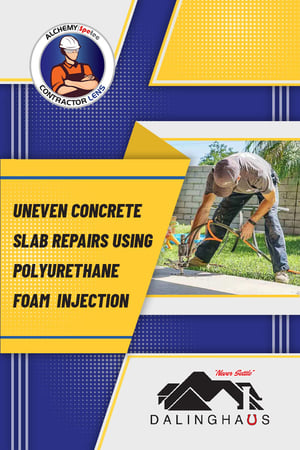
 This post is part of the Alchemy-Spetec Contractor Lens series, featuring views, news & case studies written by our customers. This article was written by Brian Dalinghaus of Dalinghaus Construction. If you're an Alchemy-Spetec customer and you'd like to discuss writing content for our blog, please send an email to marketing@alchemy-spetec.com today!
This post is part of the Alchemy-Spetec Contractor Lens series, featuring views, news & case studies written by our customers. This article was written by Brian Dalinghaus of Dalinghaus Construction. If you're an Alchemy-Spetec customer and you'd like to discuss writing content for our blog, please send an email to marketing@alchemy-spetec.com today!
Why Do Concrete Slabs Become Uneven?
Concrete slabs such as sidewalks, driveways, and patios, usually become uneven for one of the following reasons:
- Expansive soil – Expansive soil is clay-rich and for this reason expands as it soaks up moisture, and then shrinks as it loses moisture and dries out. This swelling/shrinking – which can be caused by drought/non-drought periods – causes movement in the soil under the slab, and will often cause a slab to become uneven over time.
- Erosion under the slab – Some types of soil are prone to erosion and if there’s poor drainage under the slab, this could cause voids to form and an uneven slab eventually.
- Soil not tamped down – Soil always needs to be properly compacted before anything gets placed or built on top of it, including concrete slabs. If this isn’t done, the slab could settle into the soil and end up uneven.
- Tree roots – We’ve all seen examples of tree roots pushing up on a slab and causing it to become unlevel.
- Dead leaves decaying leave voids – Leaves and other organic matter should be removed from the soil before a concrete slab is poured. If this isn’t done, voids could form under the slab. If the slab sinks into the voids, it will become uneven.
Uneven Concrete Slab Repairs Using Polyurethane Foam Injection
Fortunately, an uneven concrete slab can be repaired (i.e, leveled) in just a few hours using polyurethane foam injection, a waterproof material that’s injected under the slab in order to level it. Polyurethane foam injection can lift and level sidewalks, driveways, patios, pool decks, and more.
The general polyurethane foam injection procedure to perform concrete slab repairs is as follows:
- Dime-sized holes are drilled into the affected slab.
- A nozzle is inserted through the holes and the polyurethane foam is injected under the slab.
- The foam immediately begins to expand, fill any voids, and raise the slab.
- The holes are patched using a compound that matches the color of the concrete.
- Fifteen minutes after the repair is complete, the slab is ready for use.
Is Polyurethane Foam Better Than Mudjacking?
Yes, we believe polyurethane foam injection is better than mudjacking. Mudjacking is an older method for leveling an uneven concrete slab. Today, most concrete leveling jobs are done using polyurethane foam injection for the following reasons:
- The mudjacking slurry used to raise the slab is heavy because it contains cement, sand, soil, etc. Because of this, it has the potential to make the problem even worse because the slab might have become uneven due to weak soil that is unable to support it. If so, adding more weight to the soil in the form of a cement slurry isn’t going to help.
- The mudjacking slurry is prone to erosion if there’s poor drainage under the slab.
- The holes used to inject the mudjacking slurry under the slab are at least 2 inches wide. Compare this to the dime-sized holes used with polyurethane foam injection.
- Mudjacking is a messy process that takes 2-3 to dry and harden. This means downtime.
Yes, mudjacking is still being done today. However, we view it as a temporary fix, at best.
Are Concrete Slab Repairs Better Than Replacing The Slab?
Unless the concrete slab is severely damaged, yes, lifting the slab via polyurethane foam injection is better than digging up and replacing the slab. Concrete leveling using polyurethane foam is a quick procedure taking usually no more than a few hours and then the slab is ready for use. Pouring a new slab and then waiting for it to dry and harden takes time. Replacing a slab is also more expensive. Therefore, severely damaged slabs are typically the only cases that are not a good fit for leveling with polyurethane.
How Much Do Uneven Concrete Slab Repairs Cost?
The cost to fix an uneven concrete slab using polyurethane foam injection depends on where you live and the size of the affected area (this determines how much lifting foam is needed).
How To Help Prevent Concrete Slabs From Becoming Uneven
You can help prevent a concrete slab – such as a sidewalk or driveway – from becoming uneven, by doing the following:
- Make sure the soil is adequately tamped down before the slab gets poured on top of it.
- Ensure that any organic material (such as leaves) is removed from the soil before the slab gets poured.
- Make sure there’s good drainage under and around the slab.
- Keep trees with invasive root systems away from the slab.
If you have an uneven concrete slab that needs to be lifted and leveled (and you’re in the Dalinghaus Southern California and Arizona service area) click here to contact Dalinghaus today and schedule an evaluation.


